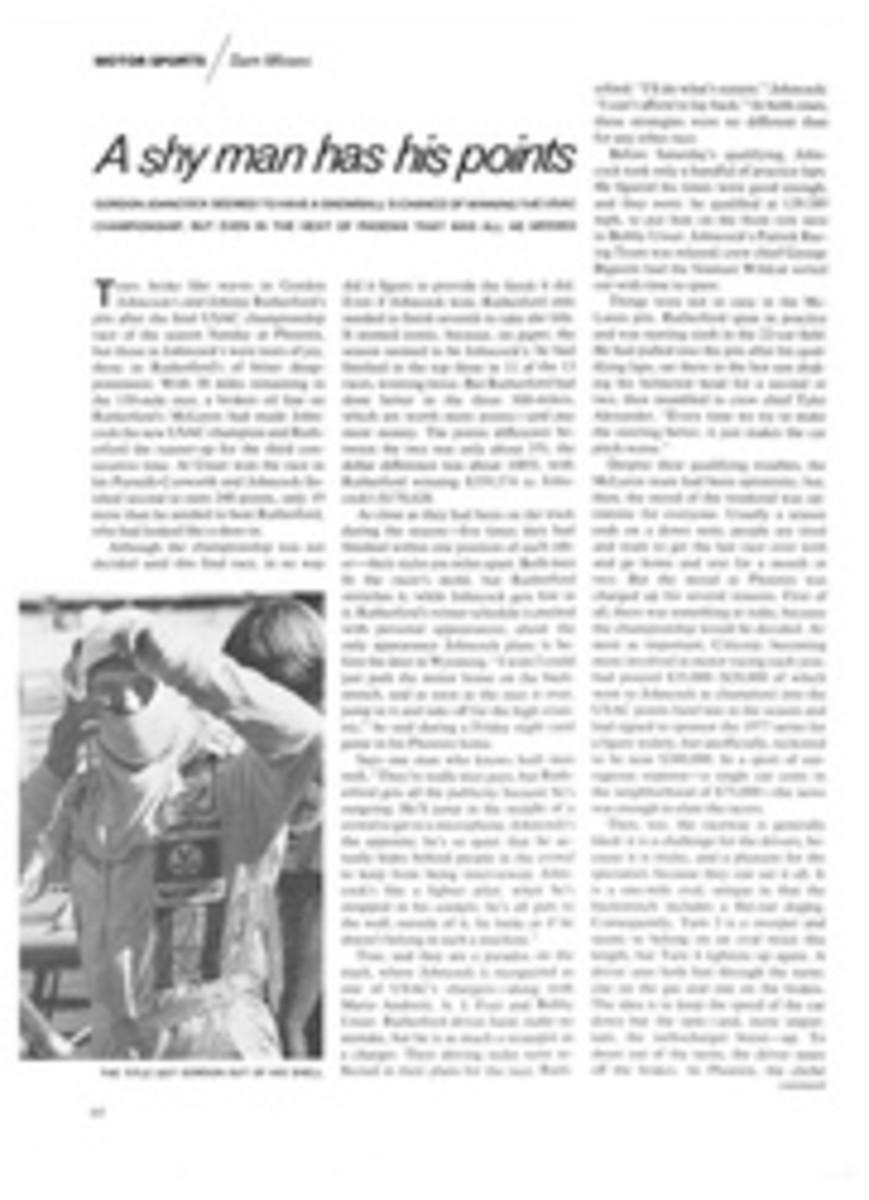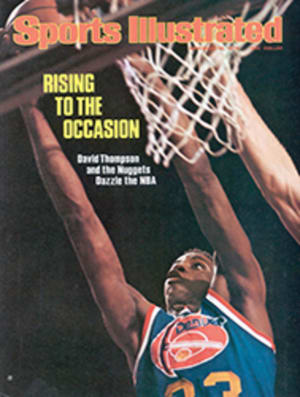
YOUTH WAS SWERVED AS THE FRENCH SWEPT
The goings-on in the days leading up to the 25th running of the Washington, D.C. International at Laurel, Md. were bizarre, almost as crazy as the running of the race itself. There was the strange sight of Fujino Pahshia, a 5-year-old representing Japan, who was walked and walked and walked under both saddle and blanket until everyone thought he would turn to butter. Janus II from Brazil went through workout after workout with a jockey on his back but no saddle whatsoever. West Germany's Windwurf was tended by his Polish jockey, Jerry Jednaszewski, who kissed women's hands while simultaneously clicking the heels of his boots. The Norwegian horse, Noble Dancer II, was not only the first horse ever to honor his nation by being invited to the International, but he was also trained by a steeplechase rider, Terje Dahl, 40, one of the best at this trade in the world. Yet certainly the oddest thing of all about the silver anniversary International was the fact that Youth and Ivanjica, both from France and the top two runners in Europe this year, would decide the championship of their continent on a gluey bog located midway between Baltimore and Washington.
The International has always been faced with one difficulty or another, and this year's renewal seemed to prove conclusively that it will never reach its 26th birthday unless drastic alterations are made. Through the years 230 horses have come to Laurel from 23 nations supposedly to meet the finest U.S. performers in what is called "The Olympics of Racing." Keeping that flame lit at Laurel through the years has cost management more than $7 million. This year, however, not a single U.S. horse got into the starting gate because the two who accepted invitations, Effervescing and Improviser, were both withdrawn—Improviser because of an injury, Effervescing because the turf course was in such poor shape that his trainer, John Russell, felt there was too great a chance for injury. So it was that only eight horses faced the starter to run 1½ miles for a purse of $150,000, with $100,000 to the winner and payments going all the way back to sixth ($5,000).
For the last 16 years the U.S. and France have dominated the International, winning seven races apiece (Ireland and England won once each), and France upheld its share of the tradition last Saturday in spectacular fashion. Youth was first by 10 widening lengths in a plodding 2:46⅕ with the two other French entries, On My Way II and Ivanjica, finishing second and third.
Two things will make the 1976 running of the race memorable. The first is that Youth proved himself a great horse, perhaps as good as Forego. The second is the splendid tactical ride Jockey Sandy Hawley gave Youth. It was a delight to watch, and it's a shame that the stewards didn't observe it more closely. With half a mile remaining, Noble Dancer II, On My Way II, Rose Bowl (from England) and Ivanjica were fanned out four wide across the track with barely a nostril separating them. Youth was in fifth place and faced with a horrendous problem. The wall of animals in front of him was certainly not going to step aside to make way for his late charge. Hawley could consider trying to circle the four up front, but if he did so he would lose a vast amount of ground and also would have to run on the softest, most difficult part of the racetrack.
So Hawley stayed back and waited for an opening. With a quarter of a mile still to run, a crack appeared and he shot Youth through it. Hawley was not yet home free, however. Taking the lead on the outside, he swerved sharply toward the rail, which caused Alfred Gibert, the rider of On My Way II, to snatch his horse up and, momentarily, stop riding.
Once clear of his opposition, Hawley set Youth down for the run to the wire. He drew out and sailed serenely away to the biggest winning margin in the history of the International. Youth had humiliated the field and incidentally won the championship of Europe, beating the seventh-place finisher, Windwurf, by some 47 lengths. (Brazil's Janus II was eased up in last place.) If Youth hadn't veered, of course, he might have won even more easily. But by causing On My Way II to be hastily checked, Youth seemed guilty of a foul.
When the field got under the wire, the stewards flashed the INQUIRY sign. That sign was soon joined by an OBJECTION light when Gibert claimed foul against Hawley. After long deliberation, both lights went out, but no OFFICIAL sign went up. Youth was led into the winner's enclosure, but the OFFICIAL sign was still not lit. Youth paraded around with Hawley aboard. Finally the OFFICIAL was flashed. It was a tawdry performance by the stewards.
While Youth represented France, he is owned by Texan Nelson Bunker Hunt and was conceived in Kentucky (Ack Ack-Gazala II by 1953 Kentucky Derby winner Dark Star) and foaled in Maryland. Packaged into a $6 million breeding syndicate, Youth will never race again. That is a shame. His entire career consisted of only 11 races, eight of which he won, with earnings of $687,624.
Hunt's success in Internationals is astonishing. He has started five horses in the race in the last four years and won it three times. In addition to this year's victory with Youth, Hunt's light-and dark-green colors also flashed home first in 1975 with Nobiliary and in '73 with Dahlia. Counting the third-place money picked up by Dahlia in 1974, Hunt has won $310,000 in the International in less than 10 minutes of racing.
The big concern about this year's race was whether Youth would even get to start. Two weeks earlier he had won the Canadian International Championship at Woodbine, outside of Toronto, in a canter. But upon arriving at Laurel he developed a cut on his right hind hoof. His trainer, Maurice Zilber, doubted that the colt would be ready to run and predicted that Ivanjica would win.
For three days Youth's status wavered between dubious and doubtful, but Zilber is a cagey man. He plays for every edge he can get, and by telling stories he often makes the opposition think hard about changing tactics. On the Tuesday before the race he watched Ivanjica and Rose Bowl work together. "I knew what I saw," Zilber said after the International. "Rose Bowl was moving better than Ivanjica. I knew then that Ivanjica was over the hill."
The small crowd of 22,762 at the track on Saturday didn't think that way at all. Until the last flash on the tote board, Youth was a slight favorite, but in the final counting, Ivanjica was pushed into the favorite spot with $46,032 bet on her to $45,616 wagered on Youth: "If the track was not off today," said Zilbert later, "Youth would have won by 20 lengths."
Between now and next year drastic changes will have to be made to keep the International afloat as a world-class race. Oh, it has a fine list of winners, but by today's standards the purse is too small. John Schapiro, who founded the race and still runs it, is hopeful that he can find a sponsor willing to put up a $500,000 purse. This year the race was not covered by television in this country, and thus there was no TV money to help defray the costs of bringing in horses and paying the participants' expenses, which have often exceeded $300,000. It would come as no great surprise if Philip Morris, which sponsors the Marlboro Cup, were to join Schapiro in promoting next year's running.
One thing that Schapiro must do before then is rebuild his turf course so that it will shed water. The trainers were furious about the condition of the course: horses' hooves plunged down into it as deep as a foot, which was why John Russell scratched Effervescing. "My horse is in a whole lot better shape than he was when he won the Man o'War at Belmont," Russell said. "But he is a speed horse and wouldn't get any traction here. You can't change the way you train a horse in a few days. The way the course is now suits the European horses much better because they are used to running over wet courses. I want to run in the International because that's my kind of thing, but I'm not going to risk the career of a 3-year-old by sending him out on a track he can be hurt on. There is very little drainage on the track. It's like a bog. I really hate to scratch, but a horseman's job is his horse."
Another major problem facing the International is the fact that the $350,000 Champions Handicap is run on the same day at Santa Anita. A purse that large naturally lures the better U.S. horses. Schapiro and the management at Santa Anita must work out the conflict. The Champions was won by King Pellinore, who turned down a bid to the International and who many feel is the best grass horse in this country. At Santa Anita, King Pellinore won on dirt.
The International has had problems before and solved them. The race will surely get other good horses, but how many like Youth? Horses like him don't come down the bog every day.
PHOTO
On the gluey Laurel turf, Jockey Sandy Hawley had to work for most of the race to get Youth through all the traffic. When he did, the colt had clear sailing.
PHOTO
One of Hunt's rewards: a buss from Liz Taylor.

